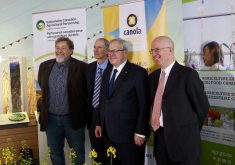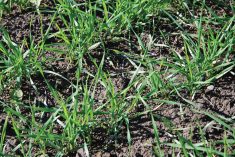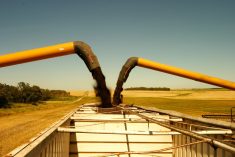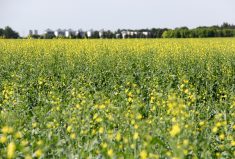For organic grain farmers without livestock such as Carnegie Farms north of Brandon, green manure has become a mainstay for nutrient management.
Visitors to the fully organic operation’s field day Aug. 4 took in two green manure mixes, ranging from peas, beans, oats and buckwheat to a field with all of the above, plus kale, phacelia, mustard and sorghum.
“The more diversity, the better,” said Allen Krueger of Carnegie Farms. “That’s kind of the key and so that’s what we’re focusing on with this (field) is more diversity. Every plant addresses different things in the soil, whether it’s nutrient cycling or just building the biology. The reason we went with less on the other quarter was just simply timing of the year and moisture levels.”
Read Also

CUSMA access key among other trade noise: Seeds Canada panel
Seeds Canada conference panelists say Canada needs to stay focused and wait as U.S. trade and tariff chaos develops, and a Canada-U.S.-Mexico Agreement review looms
Cereal crops, the farm’s specialty, will bracket every third year when green manure is sown. Carnegie Farms certified its first organic field in 2002 and has since fully transitioned.
Like all producers opting for green manure, Krueger and Carnegie Farms face the challenge of tailoring each mix for agronomics and farm goals while also developing a multi-species mixture that will grow well together.
While Krueger acknowledged that adding livestock would be ideal, green manure is the spearhead for Carnegie Farm’s fertility plan.
“For us, we don’t have access to animal manure on our farm,” he said. “We don’t have animals; we’re just strictly a grain farm and so our green manure is our focus on building fertility and biology in the soils. We’re trying to tailor our mixes just for that purpose.”
The densely vegetated, multi-species mix also plays a role in weed suppression, choking out unwanted interlopers such as thistle, a weed that stood out during the tour for its difficulty to eradicate. The stand is usually plowed down at 20 per cent flower, a stage Krueger said was chosen to optimize sugar content, but before weeds have gone to seed.
Grazing potential
While the tour focused on grain production, Bryce Lobreau, who moves up to 1,800-head of organic beef cattle per year on his farm near Pipestone, says the day’s lessons had implications on mixture development, seeding rate, seed timing and termination for his livestock-oriented operation.
“We would be grazing it in another week or two,” he said, comparing Krueger’s stand to his own farm. “We’d be turning cattle out here and intensive grazing it because there’s really no nutrient loss from grazing, so we would get the benefit of the cattle gaining weight and utilizing the forage and still gaining all the nutrients.”

Intensive, or mob, grazing has been advocated by forage and soil health experts as a means to jump-start root growth and increase organic matter, infiltration and nutrient cycling in pasture land.
The livestock producer said he has seen up to two pounds gain a day in his herd when high-quality forage such as green manure is grazed.
Most of his 1,200 acres of cropland is put to silage, he said, although his farm has also grown vegetables since it became organic in 2009.
Glenn Elliott, also from Pipestone, also cited lessons from the day. Elliott has been organic for 15 years and has frequently integrated green manure on a similar three-year cycle to Carnegie Farms.
“It was just interesting to see something like this with several different species in it to see how it’s doing. And talking with other farmers too is a good deal. You learn lots of things,” he said.
Organic alliance tours
The Aug. 4 tour was one of several organized by the Manitoba Organic Alliance and supported by the Prairie Organic Grain Initiative this summer.
Tours have included cover cropping, dairy operation, organic seed processing and cleaning, and equipment considerations in large-scale organic transition.
Kate Sjoberg, co-ordinator with the Manitoba Organic Alliance, hopes tours will lead to more connection between the province’s organic farmers.
“This is the best outcome we could hope for,” she said. “It’s really nice to have a spot where the producer is willing to share what they’re doing on their particular farm and then the value added is that people get to see each other’s faces and share what they’re doing, so this is an incredibly useful event, I think.”
Tour topics varied in an effort to better match producer interests, Sjoberg said. The Manitoba Organic Alliance has encouraged producers to share feedback of the tours in order to better plan programming.
Williment Farm and Ranch in central Manitoba is the next stop on the Manitoba Organic Alliance schedule. The tour will explore hemp production and will take place near the end of August.




















